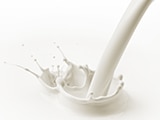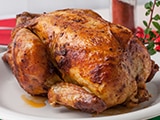In fact, working out has been shown to decrease the risk of chronic diseases like diabetes and heart disease, help keep weight in check and boost the immune system.
While there is no doubt that exercise plays an important role in health, many people wonder if working out while sick will help or hinder their recovery.
However, the answer isn’t black and white.
This article explains why sometimes it’s ok to work out when you are sick, while other times it’s best to stay home and rest.
Is It Ok to Work Out When You’re Sick?

A speedy recovery is always the goal when you are sick, but it can be hard to know when it’s ok to power through with your normal gym routine and when it’s best to take a few days off.
Exercise is a healthy habit, and it’s normal to want to continue working out, even when you’re feeling under the weather.
This can be perfectly fine in certain situations but also detrimental if you are experiencing certain symptoms.
Many experts use the “above the neck” rule when advising patients on whether to continue working out while sick.
According to this theory, if you are only experiencing symptoms that are above your neck, such as a stuffy nose, sneezing or an earache, you’re probably ok to engage in exercise.
On the other hand, if you are experiencing symptoms below your neck, like nausea, body aches, fever, diarrhea, productive cough or chest congestion, you may want to skip your workout until you feel better.
A productive cough is one in which you’re coughing up phlegm.
When It’s Safe to Exercise
Working out with the following symptoms is most likely safe, but always check with your doctor if you are unsure.
Mild Cold
A mild cold is a viral infection of the nose and throat.
Though symptoms vary from person to person, most people who have a cold experience a stuffy nose, headache, sneezing and mild cough.
If you have a mild cold, there’s no need to skip the gym if you have the energy to work out.
Although, if you feel that you lack the energy to get through your normal routine, consider reducing the intensity of your workout or shortening its duration.
While it’s generally ok to exercise with a mild cold, keep in mind that you might spread germs to others and cause them to become ill.
Practicing proper hygiene is a great way to prevent spreading your cold to others. Wash your hands frequently and cover your mouth when you sneeze or cough.
Earache
An earache is a sharp, dull or burning pain that can be located in one or both ears.
Though ear pain in children is commonly caused by infection, earache in adults is more commonly caused by pain occurring in another area, such as the throat. This pain, which is known as “referred pain,” then transfers to the ear.
Ear pain can be caused by sinus infections, sore throat, tooth infection or changes in pressure.
Working out with an earache is considered safe, as long as your sense of balance is not affected and an infection has been ruled out.
Certain types of ear infections can throw you off balance and cause fevers and other symptoms that make working out unsafe. Make sure you don’t have one of these ear infections before beginning exercise.
However, most earaches can just be uncomfortable and cause a feeling of fullness or pressure in the head.
Though exercise is likely safe when you have an earache, try to avoid exercises that put pressure on the sinus region.
An earache is a sharp, dull or burning pain that can be located in one or both ears.
Though ear pain in children is commonly caused by infection, earache in adults is more commonly caused by pain occurring in another area, such as the throat. This pain, which is known as “referred pain,” then transfers to the ear.
Ear pain can be caused by sinus infections, sore throat, tooth infection or changes in pressure.
Working out with an earache is considered safe, as long as your sense of balance is not affected and an infection has been ruled out.
Certain types of ear infections can throw you off balance and cause fevers and other symptoms that make working out unsafe. Make sure you don’t have one of these ear infections before beginning exercise.
However, most earaches can just be uncomfortable and cause a feeling of fullness or pressure in the head.
Though exercise is likely safe when you have an earache, try to avoid exercises that put pressure on the sinus region.
Stuffy Nose
Having a stuffy nose can be frustrating and uncomfortable.
If it’s associated with a fever or other symptoms like a productive cough or chest congestion, you should consider taking some time off from working out.
However, it’s ok to work out if you are only experiencing some nasal congestion.
In fact, getting some exercise may help open up your nasal passages, helping you breathe better.
Ultimately, listening to your body to determine if you feel well enough to exercise with a stuffy nose is the best bet.
Modifying your workout to accommodate your energy level is another option.
Going for a brisk walk or bike ride are great ways to stay active even when you aren't feeling up to your usual routine.
Always practice proper hygiene at the gym, especially when you have a runny nose. Wipe down equipment after you’ve used it to avoid spreading germs.
Mild Sore Throat
A sore throat is usually caused by a viral infection like the common cold or flu.
In certain situations, like when your sore throat is associated with a fever, productive cough or difficulty swallowing, you should put exercise on hold until a doctor tells you it’s ok.
However, if you are experiencing a mild sore throat caused by something like a common cold or allergies, working out is likely safe.
If you are experiencing other symptoms that are often associated with a common cold, such as fatigue and congestion, consider reducing the intensity of your normal exercise routine.
Reducing the duration of your workout is another way to modify activity when you feel well enough to workout but don’t have your usual stamina.
Staying hydrated with cool water is a great way to soothe a sore throat during exercise so you can add activity into your day.
A sore throat is usually caused by a viral infection like the common cold or flu.
In certain situations, like when your sore throat is associated with a fever, productive cough or difficulty swallowing, you should put exercise on hold until a doctor tells you it’s ok.
However, if you are experiencing a mild sore throat caused by something like a common cold or allergies, working out is likely safe.
If you are experiencing other symptoms that are often associated with a common cold, such as fatigue and congestion, consider reducing the intensity of your normal exercise routine.
Reducing the duration of your workout is another way to modify activity when you feel well enough to workout but don’t have your usual stamina.
Staying hydrated with cool water is a great way to soothe a sore throat during exercise so you can add activity into your day.
When Exercise Is Not Recommended
While exercising is generally harmless when you have a mild cold or earache, working out when you are experiencing any of the following symptoms is not recommended.
Fever
When you have a fever, your body temperature rises above its normal range, which hovers around 98.6°F (37°C). A fever can be caused by many things, but it’s most commonly triggered by a bacterial or viral infection.
Fevers can cause unpleasant symptoms like weakness, dehydration, muscle aches and loss of appetite.
Working out while you’re feverish increases the risk of dehydration and can make a fever worse.
Additionally, having a fever decreases muscle strength and endurance and impairs precision and coordination, increasing the risk of injury.
For these reasons, it’s best to skip the gym when you have a fever.
When you have a fever, your body temperature rises above its normal range, which hovers around 98.6°F (37°C). A fever can be caused by many things, but it’s most commonly triggered by a bacterial or viral infection.
Fevers can cause unpleasant symptoms like weakness, dehydration, muscle aches and loss of appetite.
Working out while you’re feverish increases the risk of dehydration and can make a fever worse.
Additionally, having a fever decreases muscle strength and endurance and impairs precision and coordination, increasing the risk of injury.
For these reasons, it’s best to skip the gym when you have a fever.
Productive or Frequent Cough
An occasional cough is a normal response to irritants or fluids in the body’s airways, and it helps keep the body healthy.
However, more frequent episodes of coughing can be a symptom of a respiratory infection like a cold, flu or even pneumonia.
While a cough associated with a tickle in the throat isn't a reason to skip the gym, a more persistent cough can be a sign you need to rest.
Although a dry, sporadic cough may not impair your ability to perform certain exercises, a frequent, productive cough is reason to skip a workout.
A persistent cough can make it difficult to take a deep breath, particularly when your heart rate rises during exercise. This makes you more likely to become short of breath and fatigued.
A productive cough that brings up phlegm or sputum may be a sign of infection or another medical condition that requires rest and should be treated by a doctor.
Furthermore, coughing is one of the main ways illnesses like the flu are spread. By going to the gym when you have a cough, you’re putting fellow gym-goers at risk of being exposed to your germs.
An occasional cough is a normal response to irritants or fluids in the body’s airways, and it helps keep the body healthy.
However, more frequent episodes of coughing can be a symptom of a respiratory infection like a cold, flu or even pneumonia.
While a cough associated with a tickle in the throat isn't a reason to skip the gym, a more persistent cough can be a sign you need to rest.
Although a dry, sporadic cough may not impair your ability to perform certain exercises, a frequent, productive cough is reason to skip a workout.
A persistent cough can make it difficult to take a deep breath, particularly when your heart rate rises during exercise. This makes you more likely to become short of breath and fatigued.
A productive cough that brings up phlegm or sputum may be a sign of infection or another medical condition that requires rest and should be treated by a doctor.
Furthermore, coughing is one of the main ways illnesses like the flu are spread. By going to the gym when you have a cough, you’re putting fellow gym-goers at risk of being exposed to your germs.
Stomach Bug
Illnesses that affect the digestive system, such as the stomach flu, can cause serious symptoms that make working out off-limits.
Nausea, vomiting, diarrhea, fever, stomach cramping and decreased appetite are all common symptoms associated with stomach bugs.
Diarrhea and vomiting put you at risk of dehydration, which physical activity worsen.
Feeling weak is common when you have a stomach ailment, increasing the chance of injury during a workout.
What’s more, many stomach illnesses like the stomach flu are highly contagious and can be easily spread to others.
If you are feeling restless during a stomach illness, light stretching or yoga at home are the safest options.
Illnesses that affect the digestive system, such as the stomach flu, can cause serious symptoms that make working out off-limits.
Nausea, vomiting, diarrhea, fever, stomach cramping and decreased appetite are all common symptoms associated with stomach bugs.
Diarrhea and vomiting put you at risk of dehydration, which physical activity worsen.
Feeling weak is common when you have a stomach ailment, increasing the chance of injury during a workout.
What’s more, many stomach illnesses like the stomach flu are highly contagious and can be easily spread to others.
If you are feeling restless during a stomach illness, light stretching or yoga at home are the safest options.
Flu Symptoms
Influenza is a contagious illness that impacts the respiratory system.
The flu causes symptoms like fever, chills, sore throat, body aches, fatigue, headache, cough and congestion.
The flu can be mild or severe, depending on the level of infection, and may even cause death in serious cases.
Although not every person who gets the flu will experience a fever, those who do are at an increased risk of dehydration, making working out a bad idea.
Though the majority of people recover from the flu in less than two weeks, choosing to engage in intense workouts while sick may prolong the flu and delay your recovery.
This is because engaging in higher-intensity activity like running or a spin class temporarily suppresses the body’s immune response.
Plus, the flu is a highly contagious virus that is spread primarily through tiny droplets people with the flu release into the air when they talk, cough or sneeze.
If you are diagnosed with the flu, it’s best to take it easy and avoid exercise while you’re experiencing symptoms.
When Is It Ok to Return to Your Routine?
Many people are anxious to get back to the gym after recovering from an illness — and for good reason.
Regular exercise can reduce your risk of becoming sick in the first place by boosting your immune system.
However, it’s important to let your body completely recover from an illness before returning to your exercise routine, and you shouldn't stress even if you are unable to work out for an extended period of time.
While some people worry that a few days off from the gym will set them back and cause a loss of muscle and strength, that’s not the case.
Many studies show that for most people, muscle loss begins after approximately three weeks without training, while strength starts to decline around the 10-day mark.
As symptoms subside, gradually begin introducing more physical activity into your day, being careful not to overdo it.
On your first day back to the gym, begin with a low-intensity, shorter workout and be sure to hydrate with water while exercising.
Remember, your body may be feeling weak, especially if you are recovering from a stomach illness or the flu, and it’s important to pay attention to how you are feeling.
If you are questioning whether you can safely work out while recovering from being sick, ask your doctor for advice.
Additionally, even though you may be feeling better, keep in mind that you might still be able to spread your illness to others. Adults are able to infect others with the flu up to seven days after first experiencing flu symptoms.
Although getting back to the gym after an illness is beneficial for your overall health, it is important to listen to your body and doctor when deciding whether you are well enough for more intense activity.
The Bottom Line
When experiencing symptoms like diarrhea, vomiting, weakness, fever or a productive cough, it’s best to rest your body and take some time off from the gym to recover.
However, if you caught a mild cold or are experiencing some nasal congestion, there’s no need to throw in the towel on your workout.
If you are feeling well enough to work out but lack your usual energy, reducing the intensity or length of your workout is a great way to stay active.
That said, to stay healthy and safe when you’re sick, it is always best to listen to your body and follow your doctor’s advice.
reprinted from healthline.com









